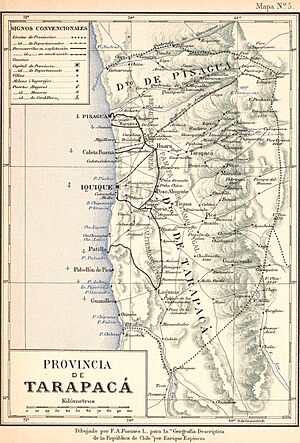Pisagua Department facts for kids
Quick facts for kids Pisagua Department
Departamento de Pisagua
|
|||||||||
|---|---|---|---|---|---|---|---|---|---|
| Department of Chile | |||||||||
| 1884–1974 | |||||||||
 Map of Tarapacá Province (1895) |
|||||||||
| Capital | Pisagua (1884-1970) Huara (1970-1979) |
||||||||
| Demonym | Pisagüino | ||||||||
| Historical era | War of the Pacific aftermath | ||||||||
|
• Established
|
31 October 1884 | ||||||||
|
• Disestablished
|
July 1974 | ||||||||
|
|||||||||
| Today part of | Chile | ||||||||
The Pisagua Department was a special area, like a county or district, in Tarapacá Province, Chile. It existed for many years, from 1883 to 1974. Before it became part of Chile, this land belonged to Peru. It was given to Chile after a big conflict called the War of the Pacific, as agreed in a peace deal known as the Treaty of Ancón.
Contents
History of Pisagua Department
How the Department Was Formed
The Pisagua Department was officially created on October 31, 1884. This happened after the War of the Pacific, a major conflict between Chile, Peru, and Bolivia. Chile won the war and gained new territories.
The new Pisagua Department became part of the larger Tarapacá Province, which was also new to Chile. Both of these areas were given to Chile under the Treaty of Ancón. This treaty was a peace agreement signed in 1883. Another area, Tacna, was also part of this agreement.
Where Was Pisagua Department?
The Pisagua Department had clear borders. To its north, it shared a border with the Arica Department. To the east, it was next to Bolivia.
To the south, it bordered the Tarapacá Department. Later, after 1928, this southern neighbor became known as the Iquique Department. Finally, to the west, the department stretched all the way to the Pacific Ocean.
See also
 In Spanish: Departamento de Pisagua para niños
In Spanish: Departamento de Pisagua para niños
- War of the Pacific
- Treaty of Ancón
- Consequences of the War of the Pacific
- Chilenization of Tacna, Arica and Tarapacá
- Tacna Province (Chile)
- Litoral Department
- Arica Province (Peru)
- Tarapacá Department (Peru)
- Tarapacá Department (Chile)


